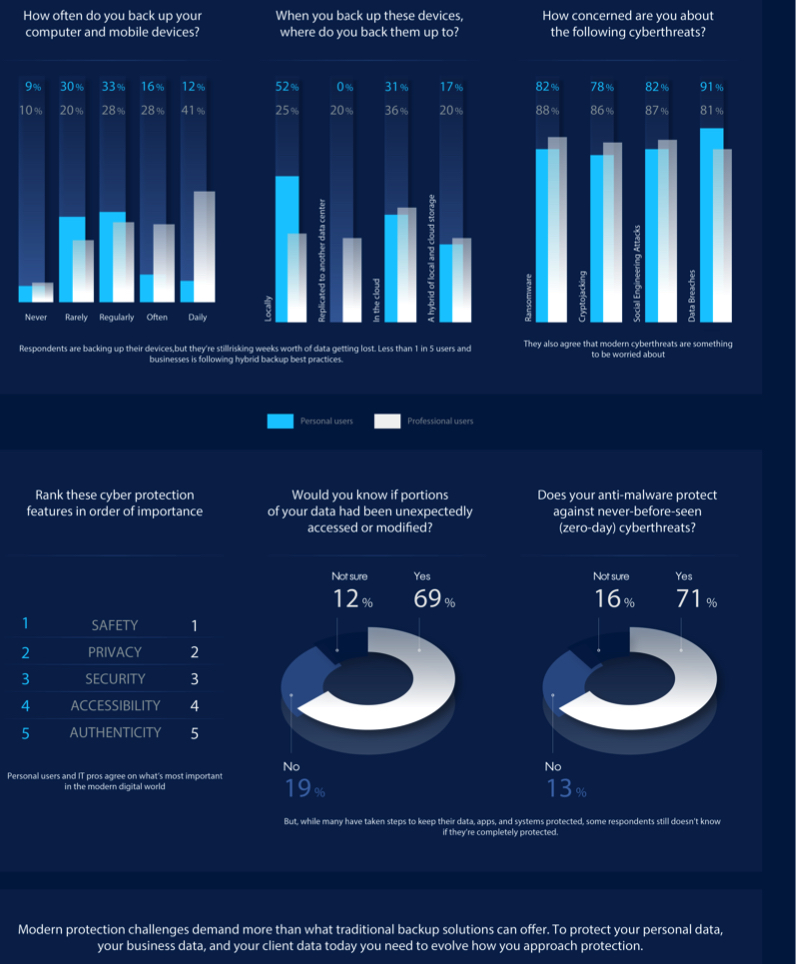42% of Organizations in World Suffered Data Loss in 2019
As only 41% backup daily
This is a Press Release edited by StorageNewsletter.com on April 8, 2020 at 2:15 pmAcronis International GmbH marked its inaugural World Cyber Protection Week by revealing that 42% of companies experienced a data loss event that resulted in downtime last year.
That number is likely caused by the fact that while nearly 90% are backing up the IT components they’re responsible for protecting, only 41% backup daily – leaving many businesses with gaps in the data available for recovery.
The figures revealed in Acronis’ 2020 World Cyber Protection Week Survey illustrate the new reality that traditional strategies and solutions to data protection are no longer able to keep up with the modern IT needs of individuals and organizations.

That is why Acronis has expanded World Backup Day – the annual holiday celebrated on March 31 as a reminder to backup data – to World Cyber Protection Week.
Annual survey, completed by nearly 3,000 people, gauges protection habits of users around globe:
- 91% of individuals backup data and devices, but 68% still lose data due to accidental deletion, hardware or software failure, or an out-of-date backup
- 85% of organizations aren’t backing up multiple times per day, only 15% report they are
- 26% backup daily, 28% backup weekly, 20% backup monthly, and 10% aren’t backing up at all
- Of those who don’t backup, nearly 50% believe backups aren’t necessary: while 42% of organizations reported data loss resulting in downtime
- Only 17% of personal users and 20% of IT professionals follow best practices, employing hybrid backups on local media and in the cloud.
These findings stress the importance of implementing a cyber protection strategy that includes backing up your data multiple times a day and practicing the 3-2-1 backup rule.
Cyber Protection Changes Game – And Game Changed Too
A peaking voume of COVID-19 related cyber scams was detected in Asia in the past 2 weeks – in China, Vietnam, South Korea and more. Singapore being one of the most exposed as a country. Both state-sponsored and freelancers – there is no shortage of those looking to prey on the fear and chaos caused by the global pandemic.
With increasing cyberattacks, traditional backup is targeted by cyber criminals and no longer sufficient
to protect data, applications, and systems
survey shows that relying on backup alone for true BC is too dangerous:
- 88% of IT professionals are concerned with ransomware, 86% cryptojacking, 87% social engineering attacks like phishing, and
- 91% data breaches. Personal users: nearly as high, rose by 33% compared to Acronis’ 2019 survey
- 30% of personal users and 12% of IT professionals wouldn’t know if their data was modified unexpectedly.
- 30% of personal users and 13% of IT professionals aren’t sure if their anti-malware solution stops zero-day threats
- 9% of organizations reported that they didn’t know if they experienced downtime as a result of data loss this year.
To ensure complete protection, secure backups must be part of an organization’s cyber protection approach, which includes ransomware protection, DR, cybersecurity, and management tools. This integrated approach also addresses the five vectors of cyber protection, delivering safety, accessibility, privacy, authenticity, and security (SAPAS) for all data, applications, and systems.
World Cyber Protection Week Recommendations
Whether you are concerned about personal files or your company’s BC, Acronis has 5 recommendations to ensure fast, efficient, and secure protection of your workloads:
- Always create backups of important data. Keep multiple copies of the backup both locally and in the cloud – to guarantee you have everything if a fire, flood, or disaster hits.
- Ensure your OSs and applications are current. Relying on outdated OSes or apps means they lack the bug fixes and security patches that help block cybercriminals from gaining access to your systems.
- Beware suspicious email, links, and attachments. Most virus and ransomware infections are the result of social engineering techniques that trick unsuspecting individuals into opening infected email attachments or clicking on links to websites that host malware.
- Install anti-virus, anti-malware, and anti-ransomware software while enabling automatic updates so your system is protected vs. malware, with the best software also able to protect vs. zero-day threats.
- Consider deploying an integrated cyber protection solution that combines backup, anti-ransomware, anti-virus, vulnerability assessment and patch management in a single solution. An integrated solution increases ease of use, efficiency and reliability of protection.













 Subscribe to our free daily newsletter
Subscribe to our free daily newsletter
